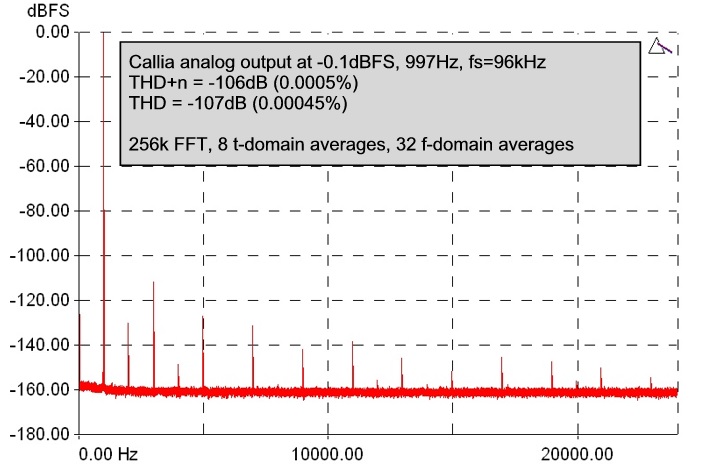





CALLIA Tech Specs
| Input selection LEDs | Indicate auto/manual select mode and current input: optical S/PDIF, RCA S/PDIF or USB. |
| Sample rate/format LEDs | Indicate sample rate: 44.1, 48, 88.2, 96, 176.4, 192, 352.8, 384 kHz, (for fs>192k see note at foot of page), DSD64 or DSD128 also indicates PCM word-length ‘> 16 bits’ (24b LED ON blue) or ‘> 24 bits’ (24b LED ON pink). |
| Line volume control | Controls the volume at the analog line outputs when enabled. (See ‘REAR PANEL -> DIP switches’) Halo setting indication. |
| Headphone output | 6.3mm stereo jack socket, with illuminated volume control |
| Standby/source button | Switches between operation and standby modes; also used for manual input selection (momentary press) and LED brigtness. |
| LED brightness | Hold Standby/source button down and twist Volume knob to adjust. |
| Analog line outputs | Two XLR male for balanced connection; two RCA sockets for unbalanced connection |
| S/PDIF inputs | RCA coaxial and TOSLINK optical formats |
| DIP switches | Enable/disable line volume control, DSD headroom select, headphone impedance setting |
| USB port | USB 2.0 B type device socket |
| Mains power | 3-pin 6A IEC inlet |
| Mac OS Support | OS X 10.5 or later on Intel and Apple M1 silicon |
| Windows OS Support | Windows Vista, 7, 8.x, 10 or later, 32 or 64 bit |
| Mac OS X audio driver | Callia is a Core Audio compliant device |
| Windows audio driver | ASIO and WDM |
| Configuration | Fully-balanced analog signal path to electronically-balanced XLRs, RCAs pseudo-balanced |
| Output amplitude | XLR: 0dBFS=14dBu; RCA: 0dBFS=2Vrms |
| Output impedance | 50Ω (both balanced and unbalanced outputs) |
| Unbalanced mode | Automatic, with bootstrapping level compensation |
| Total harmonic distortion | -107dB (0.00045%, -0.1dBFS) |
| THD+N | -106dB (0.00050%, -0.1dBFS) |
| Dynamic range | 115dB (-60dBFS) |
| Gain accuracy | ±0.05dB |
| LF roll-off | -0.05dB at 8Hz, -3dB at <1Hz |
| HF roll-off | fs = 44.1kHz: -0.05dB at 21.4kHz; -3dB at 22.0kHz fs = 48kHz: -0.05dB at 23.2kHz; -3dB at 23.9kHz fs = 96kHz: -0.05dB at 32.0kHz; -3dB at 47.8kHz fs >= 192kHz, incl. DSD64/128: -0.05dB at 32.0kHz; -3dB at 76kHz |
| Output balance | >50dB |
| Inter-channel cross-talk | 1kHz: <-135dB; 20Hz..20kHz: <-120dB |
| Inter-channel phase | 10Hz..5kHz: ±0.4°, 5kHz..20kHz: ±0.25°, 20kHz..50kHz: ±0.5°, |


| Output amplitude | 0dBFS=18.0dBu (HiZ), 14.45dBu (MedZ), 8.45dBu (LoZ) measured at top (maximum setting) of potentiometer |
| Output impedance | 4R |
| Total harmonic distortion | -104dB (0.00045%, -0.1dBFS) |
| THD+n | -103dB (0.00050%, -0.1dBFS) |
| Dynamic range | 113dB (-60dBFS) |
| Gain accuracy | ±0.05dB at top of potentiometer |
| LF roll-off | -0.05dB at 6Hz; -3dB at 1.45Hz |
| HF roll-off | fs=44.1kHz: -0.05dB at 20.3kHz; -3dB at 22.0kHz fs=48kHz: -0.05dB at 21.1kHz; -3dB at 23.9kHz fs=96kHz: -0.05dB at 27.0kHz, -3dB at 47.8kHz fs=>=192kHz, including DSD64, DSD128: -0.05dB at 27.0kHz, -3dB at 71.0kHz |
| Inter-channel cross-talk | 1kHz: <-120dB; 20Hz..20kHz: <-105dB |
| Inter-channel phase | 10Hz..5kHz: ±0.1º, 5kHz..20kHz: ±0.25º, 20kHz..50kHz: ±0.5º |
| Interface protocol | USB Audio Device Class 2.0 (UAC2) |
| Audio formats supported | PCM audio of up to 32 bit word length at sampling rates of 44k1, 48k, 88k2, 96k, 176k4, 192k, 352k8, 384k and DSD64, DSD128 in DoP frame (for fs>192k see note at foot of page). |
| Interface formats | S/PDIF (RCA and TOSLINK); RCA also accepts AES3-ID |
| Audio formats | PCM audio of up to 24 bit word length at sampling rates of 44k1, 48k, 88k2, 96k, 176k4, 192k and DSD64 in DoP frame |
| Channel Status | ignored |
| Clock recovery technology | Prism Sound CleverClox hybrid PLL |
| Synchronization sources: | Local or S/PDIF input (automatic selection) |
| Local clock accuracy | ±50ppm |
| Jitter rejection | >60dB / decade above 100Hz |
| USB Stick with software and manuals | x 1 |
| IEC mains lead | x 1 |
| USB Lead type A to B | x 1 |
Notes about DSD headroom and bit rates
In the SACD specification there was at one point an amendment to exactly what constituted the maximum permissible DSD signal level. Early SACDs were prepared with a maximum peak signal level of 0dB SACD, whereas a later annex permitted maximum peak levels up to 3.1 dB SACD.
So in designing a DSD DAC, we need to accommodate the higher level without clipping, but that means that for DSD recorded in observance of the lower maximum level we are needlessly squandering 3dB of our hard-won dynamic range. So we have provided a setting to allow you to choose how best to deploy the DAC’s available dynamic range.
In addition to the DSD64 (5.6448 Mbit/s) and DSD128 (11.2896 Mbit/s) bit rates, Callia also supports the 48kHz-derived rates of 6.144 Mbit/s and 12.288 Mbit/s. At 6.144Mbit/s in addition to the DSD LED, the 48k LED will be lit and at 12.288 Mbit/s the DSD, 48k and x2 LEDs will be lit.
Measurement conditions
Except where otherwise stated, audio performance data are RMS, unweighted, 20Hz..20kHz figures, measured at 997Hz, using fs = 96kHz and ‘+4dBu’ sensitivity settings.
A note about higher sampling rates >192kHz
From its USB interface, CALLIA can play audio at sampling rates greater than 192kHz. At these higher rates a proprietary, high performance decimation filter is used to reduce the sampling rate by a factor of 2. For example, 384kHz will be converted down to 192kHz.
In keeping with our policy of continual development, specifications are subject to amendment without notice. E&OE.
All Trade Marks Acknowledged.
